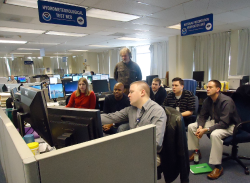
|
|
Click image for more details | |
|
Contact: Faye Barthold
|
Outcomes of the HPC Winter Weather Experiment
The new NCEP SREF (SREFP, currently scheduled for implementation in late Spring 2012) consistently provided better winter weather forecast guidance than the current operational version of the SREF, although at times the mean snowfall amounts were too high. The increased resolution in the new SREF (16 km compared to the current 32 km) provided useful forecast detail, particularly in topography where snow was confined to higher elevations. In addition to the SREFP, participants had the opportunity to explore a high resolution (4 km) convection-allowing ensemble provided by the Air Force Weather Agency (AFWA). While the AFWA ensemble was often useful for identifying the location of the heaviest snowfall, the amounts themselves were often too high.
Part of the high bias noted in the experimental guidance may be related to the snow-to-liquid ratio calculations. Both the SREFP and the AFWA ensemble used a snow-to-liquid ratio that varies based on 2 m temperature. While snow-to-liquid ratios typically increase as temperatures decrease, vertical velocities and the vertical profiles of temperature and humidity also play important roles in determining how much snow will fall. A more complete approach may require considering processes above the surface.
The mock briefings conducted during the societal impacts component exposed participants to the challenges of communicating information about complex meteorological situations to non-meteorological decision makers. For example, participants found it difficult to differentiate between projecting confidence and authority in the delivery of their briefing and conveying their level of forecast confidence. Overall, participants found the societal impacts exercise useful, and many found it directly applicable to their current positions.
The 2012 HMT-HPC Winter Weather Experiment provided a unique opportunity to bring forecasters, researchers, and model developers together to explore the challenges of probabilistic winter weather forecasting. The experiment identified important issues that will continue to be explored and raised awareness of the challenges associated with both forecasting and verifying winter weather.